17 August 2023: Clinical Research
Comparative Stress Analysis of Custom-Made PEEK Dental Post-Cores versus Conventional Post-Cores in Incisor Restorations: A Finite Element Study
Semsettin Yildiz1ABD, Samet TekinDOI: 10.12659/MSM.940887
Med Sci Monit 2023; 29:e940887
Abstract
BACKGROUND: We conducted a finite element analysis to evaluate stress levels in incisor teeth restored with custom polyetheretherketone (PEEK) dental post-cores compared to conventional post-cores.
MATERIAL AND METHODS: Using micro-computed tomography (μCT) imaging data, a 3D model of a maxillary incisor was created. For each material type, 3D mesh models were developed via specialized software. Two post diameters, 2.5 mm and 3.5 mm, were considered. Five different post materials were examined: Unfilled polyetheretherketone (Group UP); Glass fiber-reinforced polyetheretherketone (Group GP); Carbon fiber-reinforced polyetheretherketone (Group CP); Metal (Group M); and Zirconia ceramic (Group Z). Each model underwent finite element analysis, after which the von Mises equivalent stress values were determined.
RESULTS: For models involving both wide and narrow diameter posts across the crown, crown cement, post cement, and dentin, PEEK posts (Group UP, GP, and CP) exhibited higher von Mises stress values than Groups Z and M. However, the reverse trend was noticed in the post model itself. In the post cement model, stress values appeared similar only for the narrow-diameter post groups. Notably, results for Groups Z and M were largely consistent with each other.
CONCLUSIONS: PEEK posts, which have a lower modulus of elasticity, demonstrated different stress values when contrasted with zirconia and metal posts. As the post diameter expanded, the residual dentin decreased, influencing the stress values among various materials. Further in vitro and clinical examinations are essential to comprehensively understand PEEK posts.
Keywords: Dental Stress Analysis, Finite Element Analysis, polyetheretherketone, Incisor, X-Ray Microtomography, Bone Cements, Glass Ionomer Cements, Ketones
Background
Dental post and core systems (post-cores) are crucial for treating teeth that have been partially or completely damaged for various reasons [1]. Post-cores are used to extend the lifetime of treated teeth by increasing the retention of prosthetic restoration [2].
In an endodontically treated tooth restored with different post-core systems, compressive and tensile stresses at different levels occur in the root and restoration in response to chewing forces [3,4]. Behaviors of dental posts with varying elasticity were investigated in an attempt to determine the rate of treatment success and to find out which post material best reduces stresses [3–5].
Conventional post-core systems include fiber-reinforced composite (FRC) posts and ceramic posts (eg, glass ceramics, zirconium oxide-based prefabricated posts), which can be prepared as cast or prefabricated, applied to the prepared root canal [6].
Currently, although mostly prefabricated, the use of FRC posts is quite common [7]. Studies have shown that glass fiber posts have favorable characteristics, such as excellent esthetics and high tensile strength [7,8]. However, the elastic modulus of FRC posts is greater than that of the root canal dentin [6]. According to previous reports, posts with a low elastic modulus provide a more uniform distribution of occlusal loads on root dentin and cement interfaces [6].
The high elastic modulus of zirconia ceramic posts (200 GPa) limits their usage [9]. This is because fractures that may occur in teeth restored with zirconia ceramic posts are often non-restorable, and in such cases, removing these posts from the root canals is difficult [9].
Recently, a methacrylate-free high-performance polymer, polyetheretherketone (PEEK), was introduced as a novel dental material [6,10]. PEEK is a synthetic thermoplastic, tooth-colored biomaterial that is increasingly used in dentistry [6,11]. It resists thermal stress at high temperatures without significant degradation and exhibits low solubility in water [6]. PEEK prevents the release of metal ions and is neither cytotoxic nor allergenic [10]. PEEK also protects abutment teeth and other adjacent tissues, prolonging the life of the prosthesis [12].
Studies have reported that polyetheretherketone (PEEK) may be a good alternative material for addressing stress-related problems in post-core treatments due to its low elastic modulus, which is comparable to that of root canal dentin [4,6,10,11,13]. PEEK has become popular largely because of its “stress shielding” claim [10,13]. Since PEEK has a low elastic modulus, it may behave similarly to dentin when subjected to forces [14]. In dental practice, PEEK can be used as a base material, body and abutments in implants, removable prostheses, framework materials in fixed prostheses, orthodontic wires in orthodontics, space maintainers, and preformed pediatric crowns in pediatric dentistry [15,16]. PEEK can bond with resin cement and resin composites [17]. PEEK can be modified with carbon fibers, glass fibers, or ceramics. Additionally, PEEK can be fabricated using CAD-CAM, the lost-wax technique, and 3D printing, which favors its use as a post material [17,18].
Finite element analysis (FEA) is a powerful stress analysis technique that provides numerical results to evaluate the biomechanical behavior of dental materials [19]. Using computer software, the physical properties and test parameters of 3D models can be modified, and the analysis can be repeated at any time [19]. FEA is important in comparing different biomechanical behaviors in post-core treatments [19]. Many in vitro studies have been conducted using FEA on the stress distribution of various endodontically treated post-core materials [20].
Studies on the stress levels in models due to the amount of dentin remaining during the post-core processing of custom-made modified PEEK posts and conventional posts are limited. Therefore, this finite element analysis aimed to compare stress levels in models of incisor teeth restored with custom-made PEEK dental post-cores vs conventional post-cores.
The hypotheses tested in this study were as follows:
Material and Methods
ETHICS STATEMENT:
Patients who applied to the Fırat University Faculty of Dentistry between February 2023 and May 2023 were informed about the study, and signed informed consent forms were obtained from the patients who agreed to participate. Indications for extraction of maxillary incisor teeth without cracks, root fractures, internal/external apical resorption, and without endodontic treatment were included in the study. Teeth other than those meeting these criteria were excluded from the study. Ethics approval was obtained from the Local Ethics Committee of Firat University, Faculty of Dentistry (Protocol number 02-06). HP workstations equipped with an INTEL Xeon E-2286 processor with a speed of 2.40 GHz and 64 GB of ECC RAM were used to generate a 3D mesh structure, its transformation into a mathematically appropriate solid mesh structure, and the creation of 3D models for finite element analysis and finite element stress analysis.
3D CONSTRUCTING PROCESS FROM COMPUTED TOMOGRAPHY (CT) DATA:
CT data were used to create the mandibular model used in our study. A micro-CT (SkyScan1174v2e, 180° around the vertical axis, rotation step of 0.4°, and frame average of 2, with a camera exposure time of 1650 ms, using a 0.5-mm-thick aluminum filter) image of a maxillary central tooth extracted for periodontal purposes was used to simulate root anatomy. Throughout the tooth with 13.6-μm slices, a total of 886 transverse sections were obtained. The CT data were reconstructed with a slice thickness of 0.1 mm. Reconstructed CT data were transferred to 3DSlicer software in the DICOM format. Using this software, the region of interest was separated using appropriate Hounsfield units and converted into a 3D model with segmentation. Then, the 3D model was transferred to the ALTAIR Evolve software in stereolithography (STL) format, where the appropriate mandibular cortical geometry was modeled. Trabecular bone was obtained with reference to the inner surface of the 3D cortical bone of the mandible (2 mm).
MODELING OF CROWN, CEMENT, DENTIN, POST, AND PERIODONTAL LIGAMENT:
Crown models were obtained by modeling the teeth from the CT data. Wheeler’s Dental Anatomy Book was used as a reference for the dimensions of the dental crown [21].
Taking the inner surface of the crown models as a reference, a core model 2 mm above the cemento-enamel junction by creating a 2-mm ferrule effect using a 1.2-mm shoulder-type step, a 0.1-mm cement model, and post models with 2.5- and 3.5-mm diameters were constructed with reference to the inner surface of the cement models. Based on the outer surface of the root model, the periodontal ligament thickness was set at 0.25 mm.
All prepared models were placed in the correct coordinates in the 3D space using ALTAIR Evolve software; hence, the modeling process was completed (Figure 1A).
MESH CREATION:
Mathematical models were generated by discretizing the geometric space into simple and small cells, resulting in a mesh. The ALTAIR Evolve and ALTAIR Hypermesh software were used to obtain mathematical models suitable for finite element analysis. To perform the analyses, the models generated on the ALTAIR Hypermesh software were transferred to the ALTAIR Optistruct (Troy, MI, USA) analysis program in the FEM format (Figure 1B).
DESCRIPTION OF THE PROPERTIES OF MATERIALS:
In the present study, 5 different post materials (unfilled PEEK, Group UP; glass fiber-reinforced [GFR-PEEK], Group GP; carbon fiber-reinforced [CFR-PEEK], Group CP; metal [Ni-Cr], Group M; and zirconia ceramic, Group Z) were prepared. The material properties of the linear elastic materials, including the elastic modulus and Poisson’s ratio, were used for the analyses. The numerical material properties of the FEA model are presented in Table 1.
LOADING AND BOUNDARY CONDITIONS:
A uniform loading scenario was created for both models, with oblique loading at an angle of 135°. Ten analyses were performed for 2 different post diameters and 5 different post materials. Loads of 100 N were applied to food with a diameter of 8.6 mm over the maxillary central tooth. With the use of food, specified loads were distributed to the nodal points in the application areas, thereby preventing stress singularities in the regions of interest. The quantitative model data for the 2 experimental models created are presented in Table 2.
The models were fixed by limiting all degrees of freedom from the nodal points located in the superior and posterior regions of the cortical and trabecular bones, preventing movement along all 3 axes (Figure 1C).
COMBINATION OF SYSTEMS AND TYPE OF CONNECTION BETWEEN COMPONENTS:
To perform analyses on mathematical models, the surface relationships of the cells that make up the model should be defined using analytical software. Freeze-type contact was defined as ‘perfectly bonded’ in all contact areas in all models studied. This is based on collective movement, and all the materials are considered to be linearly elastic, homogeneous, and isotropic.
Results
THE VON MISES STRESS VALUES AND DISTRIBUTIONS IN THE CROWN:
When the stress distribution in the crown was evaluated after loading, it was seen that the stress was concentrated in the buccal cervical region of the crown. A similar stress concentration pattern was observed in models with different post materials and different amounts of residual dentin. Comparing the stress values for the crown among the models restored with 2.5-mm posts composed of different materials, the highest stress value (59 368 MPa) was found in Group UP and the lowest stress value (39 252 MPa) was in Group Z. Considering the stress values for the crown across the models restored with 3.5-mm posts made of different materials, Group UP showed the highest stress value (61 202 MPa), and Group Z exhibited the lowest stress value (29 765 MPa).
THE VON MISES STRESS VALUES AND DISTRIBUTIONS IN THE CROWN CEMENT:
Stress concentration was observed in the palatal cervical region of the crown cement after loading. The use of different post materials or the diameter of the post did not significantly affect the stress distribution in cement.
THE VON MISES STRESS VALUES AND DISTRIBUTIONS IN THE DENTIN:
When the stress distribution in the dentin was evaluated upon loading, it was observed that stress accumulated in the middle or gingival third of the tooth. Comparing the dentinal stress values among the models restored with 2.5-mm posts made of different materials, Group UP displayed the highest (37 682 MPa) stress value. In contrast, Group Z exhibited the lowest stress value (30 134 MPa). Regarding the dentinal stress values of the models restored with 3.5-mm posts made of different materials, Group UP exhibited the highest (40 666 MPa) and Group M (24 797 MPa) showed the lowest stress values.
THE VON MISES STRESS VALUES AND DISTRIBUTIONS IN THE RESIN CEMENT:
Regarding the stress distribution in the resin cement between the dentin and post after loading, it was found that the stress was concentrated in the middle third of the root. Comparable stress accumulation was observed among the models, irrespective of the type of post material or post diameter.
THE VON MISES STRESS VALUES AND DISTRIBUTIONS IN THE POSTS:
The stress distribution in the post upon loading generally accumulated in the middle third of the post but was concentrated in the apical region in Groups GP and CP with 3.5-mm posts. When the stress values for the crown were compared among the models restored with 2.5-mm posts composed of different materials, the highest stress value was found in Group Z (103 186 MPa), with the lowest stress value in Group UP (4615 MPa). Comparing the stress distribution in the crown among the models restored with 3.5-mm posts consisting of different materials, Group Z exhibited the highest stress value (87 450 MPa) and Group UP showed the lowest stress value (5340 MPa).
Discussion
In this study, the stress distributions in the post materials, teeth restored with these materials, and surrounding tissues were compared using finite element stress analysis. Stress values for the post and residual dentin differed depending on the post material used and the amount of residual dentin; therefore, our hypotheses were rejected. PEEK posts showed different stress values compared to zirconia and metal posts in post-core-applied teeth. In addition, as the post diameter increased, a change in the stress values of the models was observed.
The mechanical properties and elastic modulus of a material affect the transmission of the applied load. FEA study helps us identify areas that could lead to restoration failure; that is, the areas of maximum stress build-up [22,23]. In the current stress analysis, stresses generated in the incisors restored with various PEEK dental post-cores were compared to those restored with routinely used Ni-Cr and zirconia posts.
The properties of a dental post that significantly contribute to the fracture resistance of a restored tooth include its elastic modulus, diameter, and height [24]. As dental practitioners involved in research, we strive to increase dentin fracture resistance using materials with different diameters and elastic moduli, similar or dissimilar.
Studies have shown that high stresses generated on the buccal aspect of the coronal third of the root indicate an increased risk of fracture of the post-core in tooth [3,25]. In the present study, we analyzed the stress distribution in the post indicated stress concentration in the middle third or coronal third of the root. Kohal et al stated that the normal chewing force is one-third of the maximum bite force of 300 N, whereas Helkimo et al reported that the occlusal forces generated in the anterior region range from 100 to 200 N [26,27]. Loading the force at an angle of 135° is considered the most suitable method to simulate the forces that occur in different directions, such as stresses generated during function [28–30]. Consistently, a 100-N force was applied at an angle of 135°.
Toksavul et al analyzed the dentinal stress distribution of the maxillary central incisors restored with various post-cores. Zirconia ceramic post systems with a high elastic modulus created less stress in the dentin (210 GPa) compared to glass fiber-reinforced posts (45 GPa) and titanium posts (120 GPa) with low elastic moduli [31]. Similarly, in our study, greater stress occurred in zirconium posts, resulting in less stress in the dentin. It is believed that dentin fractures can be reduced by lowering the stress in dentin.
Using finite element analysis, Nahar et al evaluated the stress distribution in a tooth restored using 2 different prosthetic crown materials and 4 different post systems. Lower dentinal stress was observed using the CFR-PEEK post compared to the FRC post [4]. Likewise, among the PEEK post models, the lowest stress was observed in the posts with unfilled PEEK, whereas the highest dentinal stress occurred in the zirconium posts in our study.
Tekin et al compared PEEK and glass fiber-reinforced posts with elasticity similar to dentin using FEA [10]. Using PEEK as a post material in post-core treatments reduced the stress values in the post, post cement, and composite core models, but did not cause a significant change in the dentin and crown cement models. According to the study results, although there was no clinical follow-up of PEEK posts, it was advantageous that PEEK posts exhibited similar stress values to glass fiber-reinforced posts, which are considered to be conventional post-core treatments. The researchers found that the stress values on the tooth model varied significantly depending on the crown material rather than the post material. The present study used only the post as a variable material. According to the results of our study, similar to the results of the previous research, PEEK posts showed less stress accumulation on themselves than zirconia and metal post groups. Still, they showed higher stress values in dentin and crown cement models.
Boschian et al examined the effect of material rigidity and post diameter on the stress distribution in different components of a single tooth post-core system and reported that posts with elastic moduli greater than that of dentin could homogeneously transmit stresses to the teeth and associated structures [22]. In contrast, in the current study, it was observed that PEEK (a material with an elastic modulus closer to that of dentin) transmitted greater stress to dentin compared to zirconia and Ni-Cr (materials with high elastic moduli). With zirconia and Ni-Cr materials, stresses mostly accumulated in the post itself.
Özarslan et al used FEA to compare the deformation and stress distributions of PEEK, glass fiber, and zirconia post-core systems used in maxillary central incisor roots. They reported that PEEK post-cores generated less stress in the tooth compared to the glass fiber and zirconia post-cores [32]. In contrast, greater dentinal stress values were observed in the custom-made PEEK post models than in the zirconia post models.
In a systematic review, Alqahtani compiled studies focusing on the mechanical properties, modifications, and advantages of PEEK as a post-core material. The authors concluded that the PEEK post-core is a viable alternative material for clinical practice owing to its good mechanical and bonding features [33]. In our study, the stress distribution of custom-made PEEK post materials with different contents in the tooth and associated structures was investigated. Our results showed that since they generate a similar magnitude of stress in dentin, PEEK materials with different components can be used as an alternative in post-core treatments.
A study by Sammany et al comparing the mechanical behaviors of PEEK, CFR-PEEK, and Ni-Cr posts showed that PEEK and CFR-PEEK posts generated a stress distribution similar to that of the sound tooth model. The PEEK post system exhibited the highest stress concentration in the cement layer, whereas the CFR-PEEK post system exhibited the best stress distribution [34]. Stresses can lead to fractures within the cement, followed by debonding [35].
In our study, while the unfilled PEEK post model displayed the lowest stress concentration in the cement used for the post, all the other post materials showed similar stress values. Studies have demonstrated that increased post diameter is associated with increased fracture resistance of the post, and a reduction in the remaining dentin substrate results in weakening of the dental tissue [36]. In a study by Nokar et al comparing the fracture resistance of endodontically treated teeth restored with glass fiber posts and metal-ceramic crowns with different diameters (1.4-1.6-2 mm), it was suggested that increasing the post diameter up to 1.6 mm may increase the fracture resistance but excessive post diameters may lead to a considerable loss of the remaining dentin substrate, which significantly increases the risk of fracture [37]. In line with the findings mentioned above, we observed that a decreased amount of dentin was associated with increased dentinal stress in custom-made PEEK posts in the present study.
In a study by Özarslan et al, the fracture resistance and mode were compared among glass fiber post-composite resin core, custom-made PEEK post-core, and zirconia post-core systems with 2 different post diameters and lengths. Except for long and wide fiber posts, fracture resistance increased with increasing post diameter in all other groups [38]. However, in the current study, stress in dentin increased in the presence of a decreased amount of dentin in the custom-made PEEK models but was reduced in the Ni-Cr models.
Kumar et al compared the stress distribution in a tooth restored with fiber and metal posts with 2 different diameters (1.2 mm and 1.4 mm) using FEA. The authors suggested that using a fiber post with a large diameter would be better to reduce stress on the remaining radicular tooth structure [39]. In contrast, less remaining dentin substrate was associated with lower stress in the dentin and post in the zirconia and Ni-Cr models, but the opposite was true for the fiber post models.
In an FEA study by Ibrahim et al, in which they compared the biomechanical and thermal behavior of PEEK posts with glass fiber and titanium posts, PEEK posts showed the lowest stress values on the crown, dentin, post, and resin cement [6]. Contrary to this study, the highest stress values in the crown and dentin were observed in PEEK post models. However, in agreement with this study, low-stress values were observed in the PEEK models in the stress analysis on the post. Stress values on PEEK resin cement did not differ significantly among materials; however, PEEK posts exhibited higher stress values with reduced remaining dentin.
Teixeira et al evaluated the fracture resistance and success of custom post-cores and custom Ni-Cr posts produced with different esthetic materials such as PEEK, nano-ceramic composites, and nano-hybrid resin composites; the lowest fracture resistance was observed in PEEK post models. This study also observed a high incidence of debonding in PEEK post models [11]. In contrast, in our study, PEEK post groups exhibited higher stress values on resin cement with decreased dentin surrounding the post. This indicates that the surface properties of PEEK posts should be investigated further.
This study has several limitations. It was difficult to directly match the FEA study to clinical conditions. In addition, the finite element model created in the present study was a multifaceted, complex structure that included endodontically treated maxillary central incisors and supporting structures. All the structures were assumed to be isotropic, homogeneous, linearly elastic, and ideally bonded. In vitro and clinical studies are needed for PEEK posts.
Conclusions
Within the limitations of this FEA study, von Mises stress values were compared, and it was found that the variation of post material and diameter caused different stress values in post-core-restored teeth.
There was a difference in the stress values in the post-core restored tooth with the change of the post material. PEEK posts with a modulus of elasticity close to that of dentin showed higher stress values in the crown, crown cement, and dentin. In the post model, the stress values on zirconia and metal posts with high elastic moduli were much higher than those on PEEK posts. In post cement, all the stress values were similar in models, with a large amount of remaining dentin for all post materials, but as the amount of remaining dentin decreased, it was shown that PEEK post groups had higher stress values than zirconia and metal posts in post cement.
The decrease in the remaining dentin due to the increase in post diameter significantly reduced the stress values in all models using zirconia and metal post with high elastic modulus. As a result of the change in the amount of dentin remaining in the crown, crown cement, and dentin in PEEK posts, stress values close to each other were obtained, but the stress values on the post cement and post increased significantly. There was no significant difference between the zirconia and Ni-Cr metal posts with high modulus of elasticity.
When PEEK posts were compared within themselves in all models, the stress values in the crown, crown cement, and dentin were found to be unfilled PEEK, glass fiber-reinforced PEEK, and ceramic-reinforced PEEK, respectively, and the values found in the post cement and post were the opposite. All results of zirconia and Ni-Cr metal posts with high elasticity modulus in the current study were very close to each other.
Further in vitro and long-term follow-up studies are warranted to better understand the clinical performance of the unfilled and modified PEEK posts.
Figures
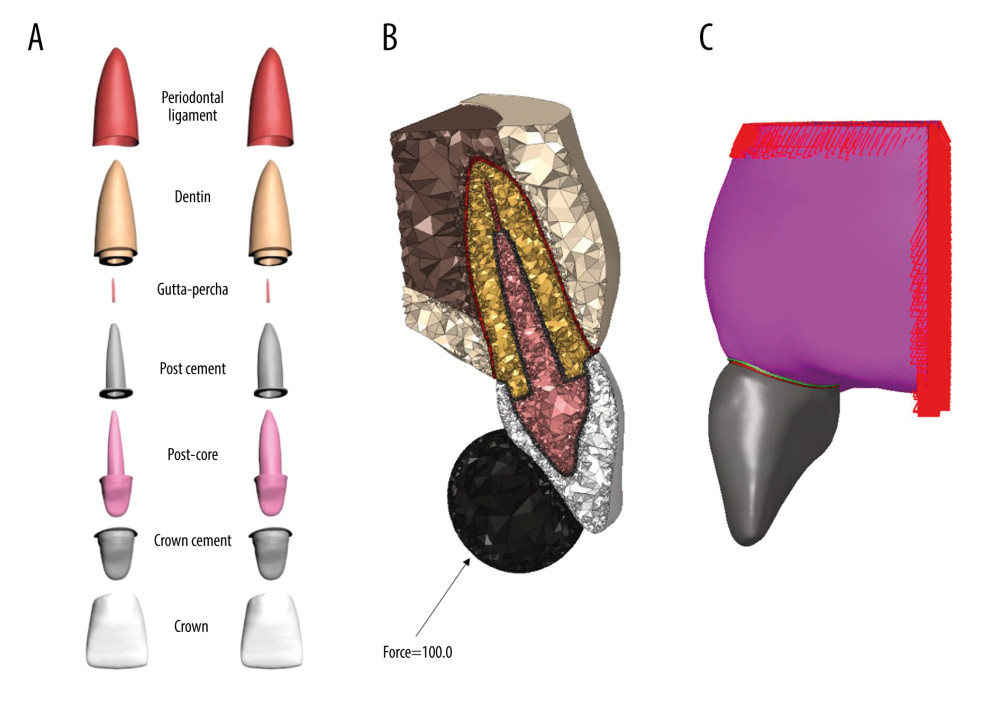 Figure 1. Analysis models with 2.5-mm and 3.5-mm diameters. Periodontal ligament, dentin, gutta-percha, post cement, post-core, crown cement, crown (A). Loading scenario (B). Boundary conditions (C). (Photoshop CS2, version 9.0, Adobe Systems).
Figure 1. Analysis models with 2.5-mm and 3.5-mm diameters. Periodontal ligament, dentin, gutta-percha, post cement, post-core, crown cement, crown (A). Loading scenario (B). Boundary conditions (C). (Photoshop CS2, version 9.0, Adobe Systems). ![von Mises stress values for all models with 2.5-mm posts (UP – unfilled PEEK; GP – glass fiber-reinforced PEEK; CP – carbon fiber-reinforced PEEK; Z – zirconia ceramic; M – metal [Ni-Cr]). (Photoshop CS2, version 9.0, Adobe Systems).](https://jours.isi-science.com/imageXml.php?i=medscimonit-29-e940887-g002.jpg&idArt=940887&w=1000) Figure 2. von Mises stress values for all models with 2.5-mm posts (UP – unfilled PEEK; GP – glass fiber-reinforced PEEK; CP – carbon fiber-reinforced PEEK; Z – zirconia ceramic; M – metal [Ni-Cr]). (Photoshop CS2, version 9.0, Adobe Systems).
Figure 2. von Mises stress values for all models with 2.5-mm posts (UP – unfilled PEEK; GP – glass fiber-reinforced PEEK; CP – carbon fiber-reinforced PEEK; Z – zirconia ceramic; M – metal [Ni-Cr]). (Photoshop CS2, version 9.0, Adobe Systems). ![The graph of the von Mises stress values of 2.5-mm posts (UP – unfilled PEEK; GP – glass fiber-reinforced PEEK; CP – carbon fiber-reinforced PEEK; Z – zirconia ceramic; M – metal [Ni-Cr]).](https://jours.isi-science.com/imageXml.php?i=medscimonit-29-e940887-g003.jpg&idArt=940887&w=1000) Figure 3. The graph of the von Mises stress values of 2.5-mm posts (UP – unfilled PEEK; GP – glass fiber-reinforced PEEK; CP – carbon fiber-reinforced PEEK; Z – zirconia ceramic; M – metal [Ni-Cr]).
Figure 3. The graph of the von Mises stress values of 2.5-mm posts (UP – unfilled PEEK; GP – glass fiber-reinforced PEEK; CP – carbon fiber-reinforced PEEK; Z – zirconia ceramic; M – metal [Ni-Cr]). ![von Mises stress values for all models with 3.5-mm posts (UP – unfilled PEEK; GP – glass fiber-reinforced PEEK; CP – carbon fiber-reinforced PEEK; Z – zirconia ceramic; M – metal [Ni-Cr]). (Photoshop CS2, version 9.0, Adobe Systems).](https://jours.isi-science.com/imageXml.php?i=medscimonit-29-e940887-g004.jpg&idArt=940887&w=1000) Figure 4. von Mises stress values for all models with 3.5-mm posts (UP – unfilled PEEK; GP – glass fiber-reinforced PEEK; CP – carbon fiber-reinforced PEEK; Z – zirconia ceramic; M – metal [Ni-Cr]). (Photoshop CS2, version 9.0, Adobe Systems).
Figure 4. von Mises stress values for all models with 3.5-mm posts (UP – unfilled PEEK; GP – glass fiber-reinforced PEEK; CP – carbon fiber-reinforced PEEK; Z – zirconia ceramic; M – metal [Ni-Cr]). (Photoshop CS2, version 9.0, Adobe Systems). ![The graph of the von Mises stress values of 3.5-mm posts (UP – unfilled PEEK; GP – glass fiber-reinforced PEEK; CP – carbon fiber-reinforced PEEK; Z – zirconia ceramic; M – metal [Ni-Cr]).](https://jours.isi-science.com/imageXml.php?i=medscimonit-29-e940887-g005.jpg&idArt=940887&w=1000) Figure 5. The graph of the von Mises stress values of 3.5-mm posts (UP – unfilled PEEK; GP – glass fiber-reinforced PEEK; CP – carbon fiber-reinforced PEEK; Z – zirconia ceramic; M – metal [Ni-Cr]).
Figure 5. The graph of the von Mises stress values of 3.5-mm posts (UP – unfilled PEEK; GP – glass fiber-reinforced PEEK; CP – carbon fiber-reinforced PEEK; Z – zirconia ceramic; M – metal [Ni-Cr]). References
1. Dejak B, Młotkowski A, Strength comparison of anterior teeth restored with ceramic endocrowns vs custom-made post and cores: J Prosthodont Res, 2018; 62(2); 171-76
2. Veríssimo C, Simamoto PC, Soares CJ, Effect of the crown, post, and remaining coronal dentin on the biomechanical behavior of endodontically treated maxillary central incisors: J Prosthet Dent, 2014; 111(3); 234-46
3. Durmuş G, Oyar P, Effects of Post-core materials on stress distribution in the restoration of mandibular second premolars: A finite element analysis: J Prosthet Dent, 2014; 112(3); 547-54
4. Nahar R, Mishra SK, Chowdhary R, Evaluation of stress distribution in an endodontically treated tooth restored with four different post systems and two different crowns – a finite element analysis: J Oral Biol Craniofac Res, 2020; 10(4); 719-26
5. Mahmoudi M, Saidi AR, Amini P, Influence of inhomogeneous dental posts on stress distribution in tooth root and interfaces: Three-dimensional finite element analysis: J Prosthet Dent, 2017; 118(6); 742-51
6. Ibrahim RO, Al-Zahawi AR, Sabri LA, Mechanical and thermal stress evaluation of PEEK prefabricated post with different head design in endodontically treated tooth: 3D-finite element analysis: Dent Mater J, 2021; 40(2); 508-18
7. Sulaiman E, Alarami N, Wong YI, The effect of fiber post location on fracture resistance of endodontically treated maxillary premolars: Dent Med Probl, 2018; 55(3); 275-79
8. Verri FR, Okumura MHT, Lemos CAA, Three-dimensional finite element analysis of glass fiber and cast metal posts with different alloys for reconstruction of teeth without ferrule: J Med Eng Technol, 2017; 41(8); 644-51
9. Bittner N, Hill T, Randi A, Evaluation of a one-piece milled zirconia post and core with different post-and-core systems: An in vitro study: J Prosthet Dent, 2010; 103(6); 369-79
10. Tekin S, Adiguzel O, Cangul S, Evaluation of the use of PEEK material in post-core and crown restorations using finite element analysis: Am J Dent, 2020; 33(5); 251-57
11. Teixeira KN, Duque TM, Maia HP, Fracture resistance and failure mode of custom-made post-and-cores of polyetheretherketone and nano-ceramic composite: Oper Dent, 2020; 45(5); 506-15
12. Wang B, Huang M, Dang P, PEEK in fixed dental prostheses: Application and adhesion improvement: Polymers (Basel), 2022; 14(12); 2323
13. Sugano K, Komada W, Okada D, Evaluation of composite resin core with prefabricated polyetheretherketone post on fracture resistance in the case of flared root canals: Dent Mater J, 2020; 39(6); 924-32
14. Najeeb S, Zafar MS, Khurshid Z, Applications of polyetheretherketone (PEEK) in oral implantology and prosthodontics: J Prosthodont Res, 2016; 60(1); 12-19
15. Tekin S, Cangül S, Adıgüzel Ö, Areas for use of PEEK material in dentistry: International Dental Research, 2018; 8(2); 84-92
16. Perween A, Mushtaq S, Chawla N, Peek: A futuristic dental material in pediatric dentistry: J Pediatr Dent, 2021; 7(2); 72-74
17. Papathanasiou I, Kamposiora P, Papavasiliou G, The use of PEEK in digital prosthodontics: A narrative review: BMC Oral Health, 2020; 20(1); 217
18. Sharma G, Vuppuluri A, Suresh K, Essential work of fracture studies of 3D Printed PEEK (Poly-ether-ether-ketone) polymer: Eng Fract Mech, 2022; 271; 108656
19. Değer Y, Adigüzel Ö, Yiğit Özer S, Evaluation of temperature and stress distribution on 2 different post systems using 3-dimensional finite element analysis: Med Sci Monit, 2015; 21; 3716-21
20. Badami V, Ketineni H, Pb S, Comparative evaluation of different post materials on stress distribution in endodontically treated teeth using the finite element analysis method: A systematic review: Cureus, 2022; 14(9); e29753
21. Nelson SJ: Wheeler’s dental anatomy, physiology and occlusion (e-book), 2014, St Louis (Missouri), Elsevier Health Sciences
22. Boschian Pest L, Guidotti S, Pietrabissa R, Stress distribution in a post-restored tooth using the three-dimensional finite element method: J Oral Rehabil, 2006; 33(9); 690-7
23. Savychuk A, Manda M, Galanis C, Stress generation in mandibular anterior teeth restored with different types of post-and-core at various levels of ferrule: J Prosthet Dent, 2018; 119(6); 965-74
24. Habibzadeh S, Rajati HR, Hajmiragha H, Fracture resistances of zirconia, cast Ni-Cr, and fiber-glass composite posts under all-ceramic crowns in endodontically treated premolars: J Adv Prosthodont, 2017; 9(3); 170-75
25. Uddanwadiker RV, Padole PM, Arya H, Effect of variation of root post in different layers of tooth: linear vs nonlinear finite element stress analysis: J Biosci Bioeng, 2007; 104(5); 363-70
26. Kohal RJ, Papavasiliou G, Kamposiora P, Three-dimensional computerized stress analysis of commercially pure titanium and yttrium-partially stabilized zirconia implants: Int J Prosthodont, 2002; 15(2); 189-94
27. Helkimo E, Carlsson GE, Carmeli Y, Bite force in patients with functional disturbances of the masticatory system: J Oral Rehabil, 1975; 2(4); 397-406
28. Bolhuis HP, de Gee AJ, Pallav P, Influence of fatigue loading on the performance of adhesive and nonadhesive luting cements for cast post-and-core buildups in maxillary premolars: Int J Prosthodont, 2004; 17(5); 571-76
29. Sorensen JA, Engelman MJ, Effect of post adaptation on fracture resistance of endodontically treated teeth: J Prosthet Dent, 1990; 64(4); 419-24
30. Isidor F, Brøndum K, Ravnholt G, The influence of post length and crown ferrule length on the resistance to cyclic loading of bovine teeth with prefabricated titanium posts: Int J Prosthodont, 1999; 12(1); 78-82
31. Toksavul S, Zor M, Toman M, Analysis of dentinal stress distribution of maxillary central incisors subjected to various post-and-core applications: Oper Dent, 2006; 31(1); 89-96
32. Özarslan M, Büyükkaplan U, Özarslan MM, Finite element stress analysis of PEEK, glass fiber and zirconia post-core systems in maxillary central incisor: Van Sağlık Bilimleri Dergisi, 2021; 14(2); 180-90
33. Alqahtani NM, The application of polyether ether ketone as post and core: A systematic review: Annals of Medical Health Sciences Research, 2021; 11(5); 1431-38
34. Sammany F, Sultan M, Ide NA-D, Stress and strain distribution in a single root canal post made of polyether ether ketone using three-dimensional finite elements method: Academic Journal of Oral and Dental Medicine, 2019; 6(1); 1-7
35. Emam M, Ghanem L, Abdel Sadek HM, Effect of different intraoral scanners and post-space depths on the trueness of digital impressions: Dent Med Probl, 2023 [Online ahead of print]
36. Hatta M, Shinya A, Vallittu PK, High-volume individual fibre post versus low volume fibre post: The fracture load of the restored tooth: J Dent, 2011; 39(1); 65-71
37. Nokar S, Mortazavi MS, Niakan SEffect of glass fiber post diameter on fracture resistance of endodontically treated teeth: Pesqui Bras Odontopediatria Clin Integr, 2020; 20; e5413 [in Portuguese]
38. Özarslan M, Büyükkaplan U, Özarslan MM, Comparison of the fracture strength of endodontically treated teeth restored with polyether ether ketone, zirconia and glass-fibre post-core systems: Int J Clin Pract, 2021; 75(9); e14440
39. Kumar P, Rao RN, Three-dimensional finite element analysis of stress distribution in a tooth restored with metal and fiber posts of varying diameters: An in-vitro study: J Conserv Dent, 2015; 18(2); 100-4
Figures
 Figure 1. Analysis models with 2.5-mm and 3.5-mm diameters. Periodontal ligament, dentin, gutta-percha, post cement, post-core, crown cement, crown (A). Loading scenario (B). Boundary conditions (C). (Photoshop CS2, version 9.0, Adobe Systems).
Figure 1. Analysis models with 2.5-mm and 3.5-mm diameters. Periodontal ligament, dentin, gutta-percha, post cement, post-core, crown cement, crown (A). Loading scenario (B). Boundary conditions (C). (Photoshop CS2, version 9.0, Adobe Systems).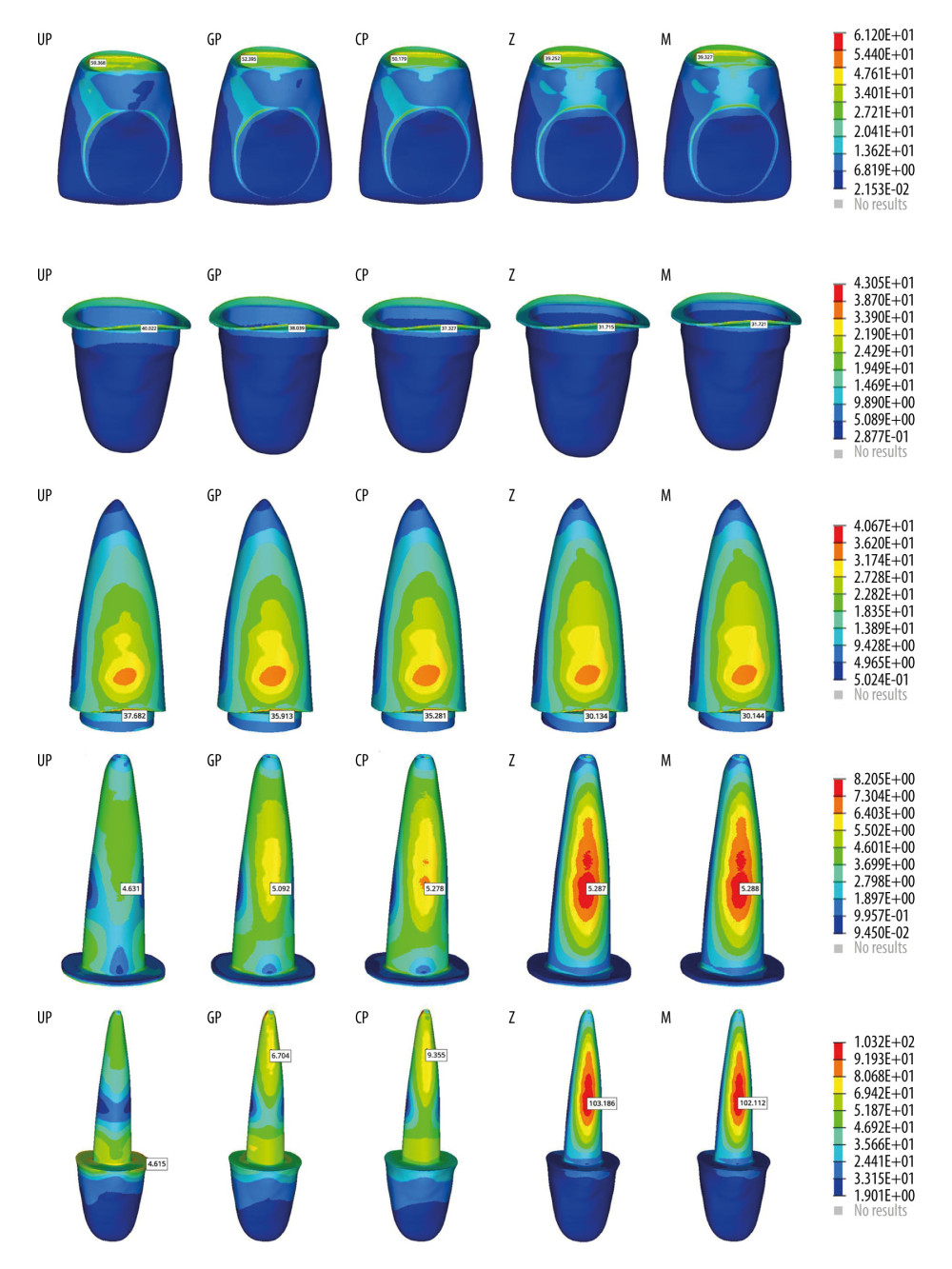 Figure 2. von Mises stress values for all models with 2.5-mm posts (UP – unfilled PEEK; GP – glass fiber-reinforced PEEK; CP – carbon fiber-reinforced PEEK; Z – zirconia ceramic; M – metal [Ni-Cr]). (Photoshop CS2, version 9.0, Adobe Systems).
Figure 2. von Mises stress values for all models with 2.5-mm posts (UP – unfilled PEEK; GP – glass fiber-reinforced PEEK; CP – carbon fiber-reinforced PEEK; Z – zirconia ceramic; M – metal [Ni-Cr]). (Photoshop CS2, version 9.0, Adobe Systems).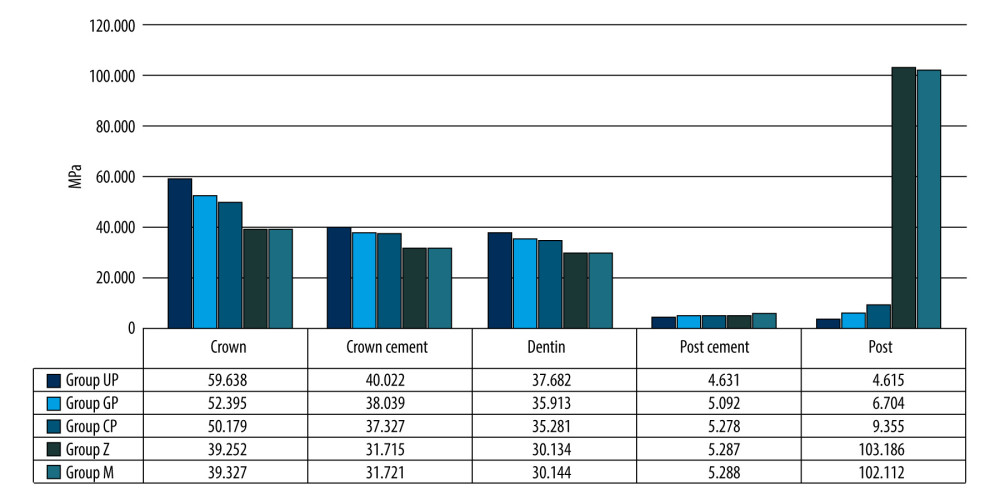 Figure 3. The graph of the von Mises stress values of 2.5-mm posts (UP – unfilled PEEK; GP – glass fiber-reinforced PEEK; CP – carbon fiber-reinforced PEEK; Z – zirconia ceramic; M – metal [Ni-Cr]).
Figure 3. The graph of the von Mises stress values of 2.5-mm posts (UP – unfilled PEEK; GP – glass fiber-reinforced PEEK; CP – carbon fiber-reinforced PEEK; Z – zirconia ceramic; M – metal [Ni-Cr]).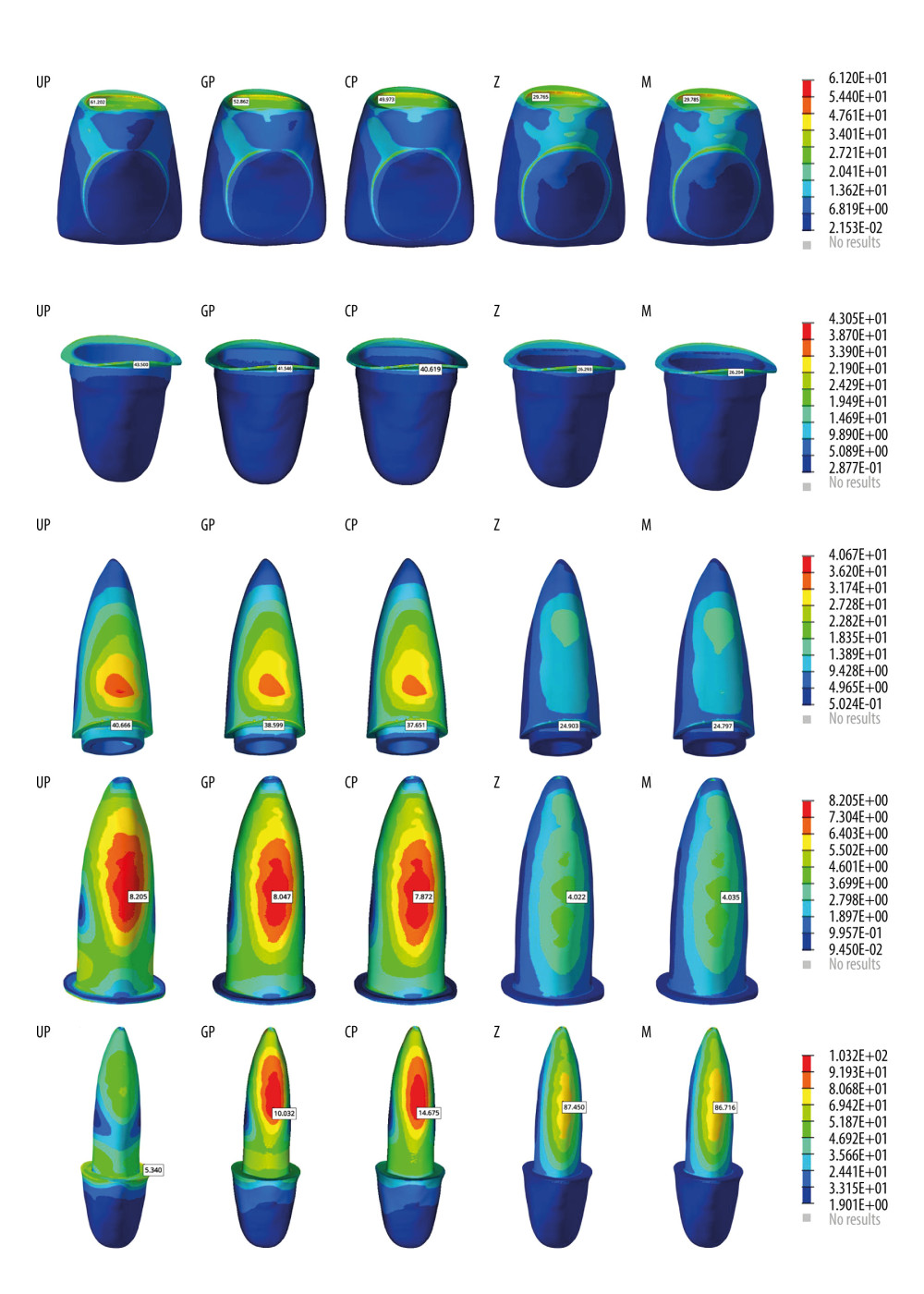 Figure 4. von Mises stress values for all models with 3.5-mm posts (UP – unfilled PEEK; GP – glass fiber-reinforced PEEK; CP – carbon fiber-reinforced PEEK; Z – zirconia ceramic; M – metal [Ni-Cr]). (Photoshop CS2, version 9.0, Adobe Systems).
Figure 4. von Mises stress values for all models with 3.5-mm posts (UP – unfilled PEEK; GP – glass fiber-reinforced PEEK; CP – carbon fiber-reinforced PEEK; Z – zirconia ceramic; M – metal [Ni-Cr]). (Photoshop CS2, version 9.0, Adobe Systems).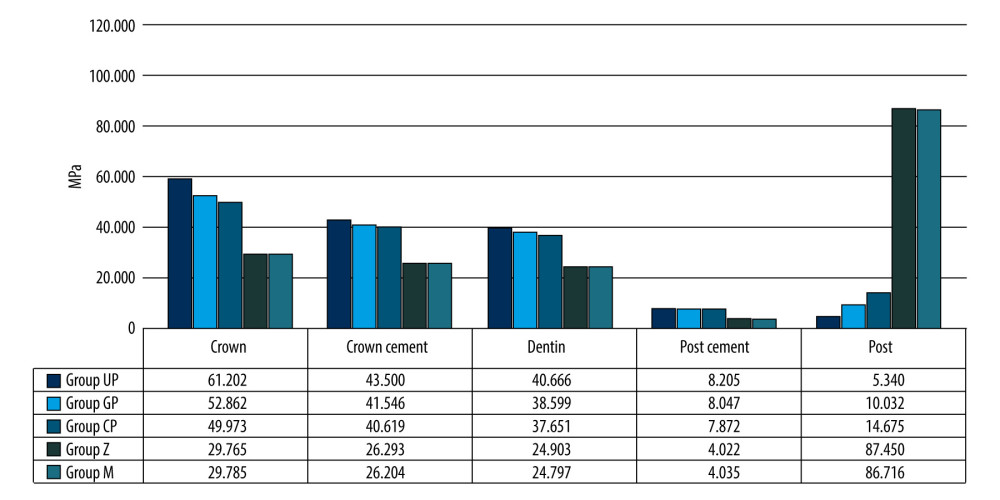 Figure 5. The graph of the von Mises stress values of 3.5-mm posts (UP – unfilled PEEK; GP – glass fiber-reinforced PEEK; CP – carbon fiber-reinforced PEEK; Z – zirconia ceramic; M – metal [Ni-Cr]).
Figure 5. The graph of the von Mises stress values of 3.5-mm posts (UP – unfilled PEEK; GP – glass fiber-reinforced PEEK; CP – carbon fiber-reinforced PEEK; Z – zirconia ceramic; M – metal [Ni-Cr]). Tables
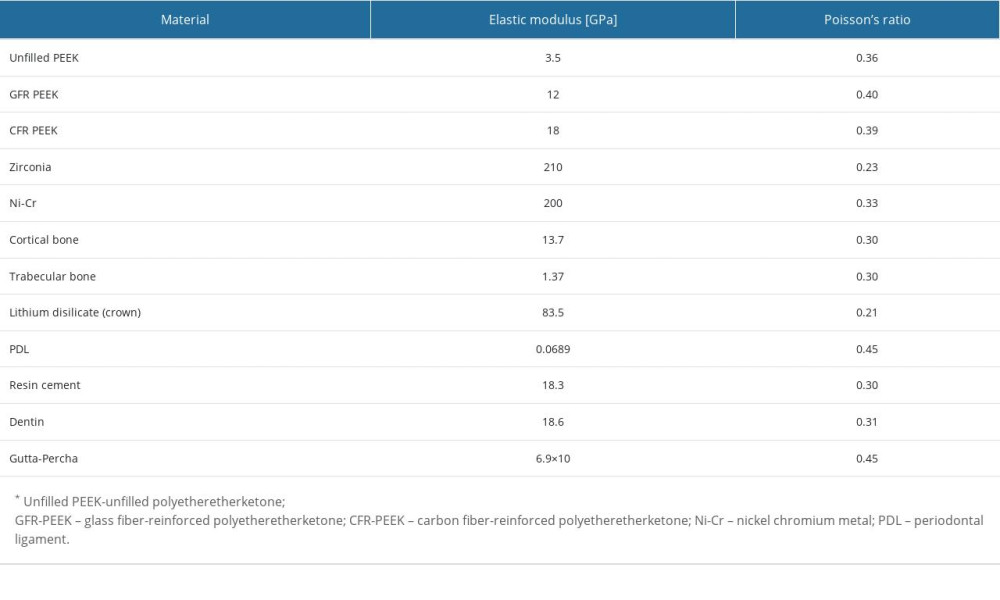 Table 1. Mechanical properties of the materials used in the finite element analysis model.
Table 1. Mechanical properties of the materials used in the finite element analysis model. Table 2. Quantitative data for 2 experimental models (2.5 mm and 3.5 mm).
Table 2. Quantitative data for 2 experimental models (2.5 mm and 3.5 mm). Table 1. Mechanical properties of the materials used in the finite element analysis model.
Table 1. Mechanical properties of the materials used in the finite element analysis model. Table 2. Quantitative data for 2 experimental models (2.5 mm and 3.5 mm).
Table 2. Quantitative data for 2 experimental models (2.5 mm and 3.5 mm). In Press
08 Mar 2024 : Animal Research
Modification of Experimental Model of Necrotizing Enterocolitis (NEC) in Rat Pups by Single Exposure to Hyp...Med Sci Monit In Press; DOI: 10.12659/MSM.943443
18 Apr 2024 : Clinical Research
Comparative Analysis of Open and Closed Sphincterotomy for the Treatment of Chronic Anal Fissure: Safety an...Med Sci Monit In Press; DOI: 10.12659/MSM.944127
08 Mar 2024 : Laboratory Research
Evaluation of Retentive Strength of 50 Endodontically-Treated Single-Rooted Mandibular Second Premolars Res...Med Sci Monit In Press; DOI: 10.12659/MSM.944110
11 Mar 2024 : Clinical Research
Comparison of Effects of Sugammadex and Neostigmine on Postoperative Neuromuscular Blockade Recovery in Pat...Med Sci Monit In Press; DOI: 10.12659/MSM.942773
Most Viewed Current Articles
17 Jan 2024 : Review article
Vaccination Guidelines for Pregnant Women: Addressing COVID-19 and the Omicron VariantDOI :10.12659/MSM.942799
Med Sci Monit 2024; 30:e942799
14 Dec 2022 : Clinical Research
Prevalence and Variability of Allergen-Specific Immunoglobulin E in Patients with Elevated Tryptase LevelsDOI :10.12659/MSM.937990
Med Sci Monit 2022; 28:e937990
16 May 2023 : Clinical Research
Electrophysiological Testing for an Auditory Processing Disorder and Reading Performance in 54 School Stude...DOI :10.12659/MSM.940387
Med Sci Monit 2023; 29:e940387
01 Jan 2022 : Editorial
Editorial: Current Status of Oral Antiviral Drug Treatments for SARS-CoV-2 Infection in Non-Hospitalized Pa...DOI :10.12659/MSM.935952
Med Sci Monit 2022; 28:e935952








